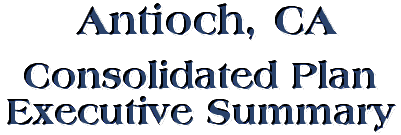

As a participating member of the County of Contra Costa Home Consortia, the City of Antioch has assisted in the development and submission of the Consortia's Consolidated Plan. Each member jurisdiction produces its own Non-Housing Needs portion of the Consolidated Plan and its own One Year Action Plan which along with other participating jurisdictions is subsequently incorporated into the Consortia's 1995-99 Consolidated Plan (a summary is on the internet under County of Contra Costa).
The City of Antioch's 1995 Action Plan constitutes an application for $743,000 in Community Development Block Grant (CDBG) program funds. Other funding sources anticipated for 1995 program use include $34,500 in anticipated 1995-96 program income, $49,000 in 1994-95 program income, and $21,000 from un-allocated carryover funds.
Three public hearings were held prior to funding sub-recipients for the 1995-96 program year. The public hearings occurred on December 21, 1994; March 6, 1995, which was continued to March 16th and March 20th; and April 25, 1995. The primary purpose of the first public hearing, held on December 21, 1994, was to receive input on local housing and non-housing Community Development Needs. The March meetings were held to interview applicants for upcoming program year and all public hearings were open to the public.
The April 25th meeting was a regular meeting of the Antioch City Council
during which the Plan was opened for public discussion. The City of Antioch
also participated in the public hearings held by the Contra Costa Consortium.
The City of Antioch's General Plan includes specific goals and policies associated with Social Services - Seniors, Child Care/Youth Services, Economic Development, and the City's Five-Year Capital Improvement Plan identifies intended course of action in addressing capital needs including public facilities.
The City's adopted Public Facilities Objectives include:
The following objectives were developed by the City of Antioch to fulfill the local needs as identified in the Consolidated Plan for the 1995-96 Program Year:
In order to achieve these stated objectives the City of Antioch proposes to utilize its 1995- 96 CDBG funds for 24 projects:
| Sidewalk Repair | $25,000 |
| Emergency Shelter Improvements | 36,400 |
| Rental Housing Rehabilitation | 250,000 |
| Owner-Occupied Housing Rehabilitation | 117,500 |
| Residential Parcel Acquisition | 150,000 |
| Aids Support/Education | 12,000 |
| Abuse Prevention | 13,000 |
| Housing-related Legal Advice | 10,000 |
| Senior Legal Service | 5,000 |
| Child Care Assistance | 1,250 |
| Crisis Services | 10,000 |
| Care for Terminally-ill AIDS Patients | 4,000 |
| Care for Terminally-ill | 4,000 |
| Handicap Assistance | 12,000 |
| Home Meals | 5,000 |
| Elderly Service | 12,000 |
| Assistance to Victims of Rape | 7,000 |
| Housing Counseling | 15,000 |
| General Management | 104,000 |
| Public Information | 5,000 |
| Planning/Urban Environmental Design | 25,000 |
| Policy/Planning/Management Capacity Building | 3,000 |
| Contingency | 14,850 |
MAP 2 depicts points of interest and low-moderate income areas.
MAP 3 depicts points of interest, low-moderate income areas, and minority concentration levels.
MAP 4 depicts points of interest, low-moderate income areas, and unemployment levels.
MAP 5 depicts points of interest, low-moderate income areas, unemployment levels, and proposed HUD funded projects; in addition, a table provides information about the project(s).